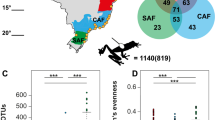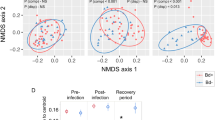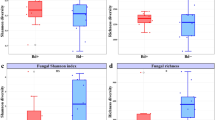Abstract
Fluctuating environments can modulate host–pathogen interactions by providing a temporary advantage to one of the interacting organisms. However, we know very little about how environmental conditions facilitate beneficial interactions between hosts and their microbial communities, resulting in individual persistence with a particular pathogen. Here, we experimentally infected Eleutherodactylus coqui frogs with the fungal pathogen Batrachochytrium dendrobatidis (Bd) under environmental conditions known to confer the survival advantage to the host during the warm-wet season, or alternatively to the pathogen during the cool-dry season. We used 16S rRNA amplicon sequencing to quantify changes in bacterial richness and phylogenetic diversity, and identified operational taxonomic units (OTUs) that became overrepresented or suppressed as a consequence of Bd infection. During the warm-wet season, frogs limited Bd infections, recruited putatively beneficial bacteria and returned to pre-infection levels of richness and phylogenetic diversity. In contrast, during the cool-dry season, Bd infections kept increasing through time, and bacterial diversity remained constant. Our findings confirm that infection outcome not only depends on abiotic factors, but also on biotic interactions between hosts and their associated bacterial communities.
Similar content being viewed by others
Log in or create a free account to read this content
Gain free access to this article, as well as selected content from this journal and more on nature.com
or
References
Antwis RE, Preziosi RF, Harrison XA, Garner TW . (2015). Amphibian symbiotic bacteria do not show universal ability to inhibit growth of the global pandemic lineage of Batrachochytrium dendrobatidis. Appl Environ Microbiol 81: 3706–3711.
Bates D, Maechler M, Bolker B, Walker S . (2015). Fitting linear mixed-effects models using lme4. J Stat Softw 67: 1–48.
Beard KH, McCullough S, Eschtruth AK . (2003). Quantitative assessment of habitat preferences for the Puerto Rican terrestrial frog, Eleutherodactylus coqui. J Herpetol 37: 10–17.
Becker CG, Rodriguez D, Longo AV, Talaba AL, Zamudio KR . (2012). Disease risk in temperate amphibian populations is higher at closed-canopy sites. PLoS One 7: e48205.
Becker MH, Harris RN . (2010). Cutaneous bacteria of the redback salamander prevent morbidity associated with a lethal disease. PLoS One 5: e10957.
Becker MH, Richards-Zawacki CL, Gratwicke B, Belden LK . (2014). The effect of captivity on the cutaneous bacterial community of the critically endangered Panamanian golden frog (Atelopus zeteki. Biol Conserv 176: 199–206.
Becker MH, Walke JB, Cikanek S, Savage AE, Mattheus N, Santiago CN et al. (2015). Composition of symbiotic bacteria predicts survival in Panamanian golden frogs infected with a lethal fungus. Proc R Soc B 282: 20142881.
Bell SC, Alford RA, Garland S, Padilla G, Thomas AD . (2013). Screening bacterial metabolites for inhibitory effects against Batrachochytrium dendrobatidis using a spectrophotometric assay. Dis Aquat Org 103: 77–85.
Bokulich NA, Subramanian S, Faith JJ, Gevers D, Gordon JI, Knight R et al. (2013). Quality-filtering vastly improves diversity estimates from Illumina amplicon sequencing. Nat Methods 10: 57–59.
Boyle DG, Boyle DB, Olsen V, Morgan JA, Hyatt AD . (2004). Rapid quantitative detection of chytridiomycosis (Batrachochytrium dendrobatidis in amphibian samples using real-time Taqman PCR assay. Dis Aquat Org 60: 141–148.
Brucker RM, Harris RN, Schwantes CR, Gallaher TN, Flaherty DC, Lam BA et al. (2008). Amphibian chemical defense: antifungal metabolites of the microsymbiont Janthinobacterium lividum on the salamander Plethodon cinereus. J Chem Ecol 34: 1422–1429.
Caporaso JG, Bittinger K, Bushman FD, DeSantis TZ, Andersen GL, Knight R . (2010a). PyNAST: a flexible tool for aligning sequences to a template alignment. Bioinformatics 26: 266–267.
Caporaso JG, Kuczynski J, Stombaugh J, Bittinger K, Bushman FD, Costello EK et al. (2010b). QIIME allows analysis of high-throughput community sequencing data. Nat Methods 7: 335–336.
Caporaso JG, Lauber CL, Walters WA, Berg-Lyons D, Huntley J, Fierer N et al. (2012). Ultra-high-throughput microbial community analysis on the Illumina HiSeq and MiSeq platforms. ISME J 6: 1621–1624.
Cramp RL, McPhee RK, Meyer EA, Ohmer ME, Franklin CE . (2014). First line of defence: the role of sloughing in the regulation of cutaneous microbes in frogs. Conserv Physiol 2: 1–12.
Daskin JH, Bell SC, Schwarzkopf L, Alford RA . (2014). Cool temperatures reduce antifungal activity of symbiotic bacteria of threatened amphibians—implications for disease management and patterns of decline. PLoS One 9: e100378.
DeSantis TZ, Hugenholtz P, Larsen N, Rojas M, Brodie EL, Keller K et al. (2006). Greengenes, a chimera-checked 16S rRNA gene database and workbench compatible with ARB. Appl Environ Microbiol 72: 5069–5072.
Edgar RC . (2010). Search and clustering orders of magnitude faster than BLAST. Bioinformatics 26: 2460–2461.
Ellison AR, Savage AE, DiRenzo GV, Langhammer P, Lips KR, Zamudio KR . (2014). Fighting a losing battle: vigorous immune response countered by pathogen suppression of host defenses in the chytridiomycosis-susceptible frog Atelopus zeteki. G3 4: 1275–1289.
Ellison AR, Tunstall T, DiRenzo GV, Hughey MC, Rebollar EA, Belden LK et al. (2015). More than skin deep: functional genomic basis for resistance to amphibian chytridiomycosis. Genome Biol Evol 7: 286–298.
Fisher MC, Henk DA, Briggs CJ, Brownstein JS, Madoff LC, McCraw SL et al. (2012). Emerging fungal threats to animal, plant and ecosystem health. Nature 484: 186–194.
Franks A, Egan S, Holmström C, James S, Lappin-Scott H, Kjelleberg S . (2006). Inhibition of fungal colonization by Pseudoalteromonas tunicata provides a competitive advantage during surface colonization. Appl Environ Microbiol 72: 6079–6087.
Greenspan SE, Longcore JE, Calhoun AJ . (2012). Host invasion by Batrachochytrium dendrobatidis: fungal and epidermal ultrastructure in model anurans. Dis Aquat Org 100: 201–210.
Jani AJ, Briggs CJ . (2014). The pathogen Batrachochytrium dendrobatidis disturbs the frog skin microbiome during a natural epidemic and experimental infection. Proc Natl Acad Sci USA 111: E5049–E5058.
Lauer A, Simon MA, Banning JL, Andre E, Duncan K, Harris RN . (2007). Common cutaneous bacteria from the eastern red-backed salamander can inhibit pathogenic fungi. Copeia, 630–640.
Lenth RV, Hervé M . (2016). Least-squares means: The R package lsmeans. J Stat Softw 69: 1–33.
Longo AV, Burrowes PA, Joglar RL . (2010). Seasonality of Batrachochytrium dendrobatidis infection in direct-developing frogs suggests a mechanism for persistence. Dis Aquat Org 92: 253–260.
Longo AV, Ossiboff RJ, Zamudio KR, Burrowes PA . (2013). Lability in host defenses: terrestrial frogs die from chytridiomycosis under enzootic conditions. J Wildl Dis 49: 197–199.
Longo AV, Savage AE, Hewson I, Zamudio KR . (2015). Seasonal and ontogenetic variation of skin microbial communities and relationships to natural disease dynamics in declining amphibians. R Soc Open Sci 2: 140377.
Loudon AH, Woodhams DC, Parfrey LW, Archer H, Knight R, McKenzie V et al. (2013). Microbial community dynamics and effect of environmental microbial reservoirs on red-backed salamanders (Plethodon cinereus. ISME J 8: 830–840.
Love MI, Huber T, Anders HJ . (2014). Moderated estimation of fold change and dispersion for RNA-seq data with DESeq2. Genome Biol 15: 550.
Maniero GD, Carey C . (1997). Changes in selected aspects of immune function in the leopard frog, Rana pipiens, associated with exposure to cold. J Comp Physiol B 167: 256–263.
Maraki S, Sarchianaki E, Barbagadakis S . (2012). Myroides odoratimimus soft tissue infection in an immunocompetent child following a pig bite: case report and literature review. Braz J Infect Dis 16: 390–392.
McMahon TA, Sears BF, Venesky MD, Bessler SM, Brown JM, Deutsch K et al. (2014). Amphibians acquire resistance to live and dead fungus overcoming fungal immunosuppression. Nature 511: 224–227.
McMurdie PJ, Holmes EC . (2013). phyloseq: An R package for reproducible interactive analysis and graphics of microbiome census data. PLoS One 8: e61217.
McMurdie PJ, Holmes S . (2014). Waste not, want not: why rarefying microbiome data is inadmissible. PLoS Comput Biol 10: e1003531.
Meyer EA, Cramp RL, Bernal MH, Franklin CE . (2012). Changes in cutaneous microbial abundance with sloughing: possible implications for infection and disease in amphibians. Dis Aquat Organ 101: 235–242.
Muletz CR, Myers JM, Domangue RJ, Herrick JB, Harris RN . (2012). Soil bioaugmentation with amphibian cutaneous bacteria protects amphibian hosts from infection by Batrachochytrium dendrobatidis. Biol Conserv 152: 119–126.
Murphy PJ, St-Hilaire S, Corn PS . (2011). Temperature, hydric environment, and prior pathogen exposure alter the experimental severity of chytridiomycosis in boreal toads. Dis Aquat Organ 95: 31–42.
Ohmer MEB, Cramp RL, White CR, Franklin CE . (2014). Skin sloughing rate increases with chytrid fungus infection load in a susceptible amphibian. Funct Ecol 29: 674–682.
Oksanen J, Blanchet FG, Kindt R, Legendre P, Minchin PR, O’Hara RB et al. (2015) vegan: Community Ecology Package, R package version 22-1. Available at: https://CRAN.R-project.org/package=vegan.
R Core Team. (2014) R: A Language and Environment for Statistical Computing. R Foundation for Statistical Computing: Vienna, Austria.
Raffel TR, Rohr JR, Kiesecker JM, Hudson PJ . (2006). Negative effects of changing temperature on amphibian immunity under field conditions. Funct Ecol 20: 819–828.
Rebollar EA, Hughey MC, Medina D, Harris RN, Ibanez R, Belden LK . (2016). Skin bacterial diversity of Panamanian frogs is associated with host susceptibility and presence of Batrachochytrium dendrobatidis. ISME J 10: 1682–1695.
Ribas L, Li MS, Doddington BJ, Robert J, Seidel JA, Kroll JS et al. (2009). Expression profiling the temperature-dependent amphibian response to infection by Batrachochytrium dendrobatidis. PLoS One 4: e8408.
Rideout JR, He Y, Navas-Molina JA, Walters WA, Ursell LK, Gibbons SM et al. (2014). Subsampled open-reference clustering creates consistent, comprehensive OTU definitions and scales to billions of sequences. PeerJ 2: e545.
Rollins-Smith LA, Reinert LK, Burrowes PA . (2015). Coqui frogs persist with the deadly chytrid fungus despite a lack of defensive antimicrobial peptides. Dis Aquat Org 113: 81–83.
Rowley JJL, Alford RA . (2013). Hot bodies protect amphibians against chytrid infection in nature. Sci Rep 3: 1515.
Roy BA, Kirchner JW . (2000). Evolutionary dynamics of pathogen resistance and tolerance. Evolution 54: 51–63.
Savage AE, Zamudio KR . (2011). MHC genotypes associate with resistance to a frog-killing fungus. Proc Natl Acad Sci USA 108: 16705–16710.
Savage AE, Terrell KA, Gratwicke B, Mattheus NM, Augustine L, Fleischer RC . (2016). Reduced immune function predicts disease susceptibility in frogs infected with a deadly fungal pathogen. Conserv Physiol 4: 1–11.
Voyles J, Young S, Berger L, Campbell C, Voyles WF, Dinudom A et al. (2009). Pathogenesis of chytridiomycosis, a cause of catastrophic amphibian declines. Science 326: 582–585.
Voyles J, Johnson LR, Briggs CJ, Cashins SD, Alford RA, Berger L et al. (2012). Temperature alters reproductive life history patterns in Batrachochytrium dendrobatidis, a lethal pathogen associated with the global loss of amphibians. Ecol Evol 2: 2241–2249.
Walke JB, Becker MH, Loftus SC, House LL, Cormier G, Jensen RV et al. (2014). Amphibian skin may select for rare environmental microbes. ISME J 8: 2207–2217.
Walke JB, Becker MH, Loftus SC, House LL, Teotonio TL, Minbiole KPC et al. (2015). Community structure and function of amphibian skin microbes: an experiment with bullfrogs exposed to a chytrid fungus. PLoS One 10: e0139848.
Wargo MJ, Hogan DA . (2006). Fungal–bacterial interactions: a mixed bag of mingling microbes. Curr Opin Microbiol 9: 359–364.
Woodhams DC, Alford RA, Marantelli G . (2003). Emerging disease of amphibians cured by elevated body temperature. Dis Aquat Org 55: 65–67.
Woodhams DC, Alford RA, Briggs CJ, Johnson M, Rollins-Smith LA . (2008). Life-history trade-offs influence disease in changing climates: strategies of an amphibian pathogen. Ecology 89: 1627–1639.
Woodhams DC, Alford RA, Antwis RE, Archer H, Becker MH, Belden LK et al. (2015). Antifungal isolates database of amphibian skin-associated bacteria and function against emerging fungal pathogens. Ecology 96: 595–595.
Yasumiba K, Bell S, Alford R . (2016). Cell density effects of frog skin bacteria on their capacity to inhibit growth of the chytrid fungus, Batrachochytrium dendrobatidis. Microb Ecol 71: 124–130.
Acknowledgements
We thank AE Ellison, MM Gray and C McDonald for harvesting and shipping Bd zoospores, and help in the lab. AL López-Torres, D Rodriguez, BB Johnson, CA Rodríguez-Gómez, M Longo, D Cancel and M Rodríguez-Medina provided invaluable help in the field by capturing frogs or by assisting during the mesocosm experiment. We also thank PA Burrowes and RL Joglar for access to the lab at the University of Puerto Rico. LM Johnson (Cornell University Statistical Consulting Unit) helped develop the regression models for this study. The Lips Lab at University of Maryland, I Hewson at Cornell University and three anonymous referees provided valuable comments and edits on earlier versions of this manuscript. Grants from the National Science Foundation Evolutionary Processes (DEB-1120249 to KRZ) and Doctoral Dissertation Improvement (DEB-1310036 to KRZ and AVL) programs provided support for this study. AVL was supported by the following fellowships and grants: Ford Foundation Predoctoral Fellowship, Cornell University (CU) SUNY/Sage Diversity Fellowships, CU Department of Ecology and Evolutionary Biology Grants, CU Graduate School Travel Grant, Andrew W. Mellon Graduate Student Grants and Atkinson’s Center for Sustainable Biodiversity Fund.
Author information
Authors and Affiliations
Corresponding author
Ethics declarations
Competing interests
The authors declare no conflict of interest.
Additional information
Supplementary Information accompanies this paper on The ISME Journal website
Rights and permissions
About this article
Cite this article
Longo, A., Zamudio, K. Environmental fluctuations and host skin bacteria shift survival advantage between frogs and their fungal pathogen. ISME J 11, 349–361 (2017). https://doi.org/10.1038/ismej.2016.138
Received:
Revised:
Accepted:
Published:
Issue date:
DOI: https://doi.org/10.1038/ismej.2016.138
This article is cited by
-
Linking microbiome and stress hormone responses in wild tropical treefrogs across continuous and fragmented forests
Communications Biology (2023)
-
Environmental and Anthropogenic Factors Shape the Skin Bacterial Communities of a Semi-Arid Amphibian Species
Microbial Ecology (2023)
-
The skin microbiota of the axolotl Ambystoma altamirani is highly influenced by metamorphosis and seasonality but not by pathogen infection
Animal Microbiome (2022)
-
Habitat Disturbance Linked with Host Microbiome Dispersion and Bd Dynamics in Temperate Amphibians
Microbial Ecology (2022)
-
The skin microbiome of Xenopus laevis and the effects of husbandry conditions
Animal Microbiome (2021)



